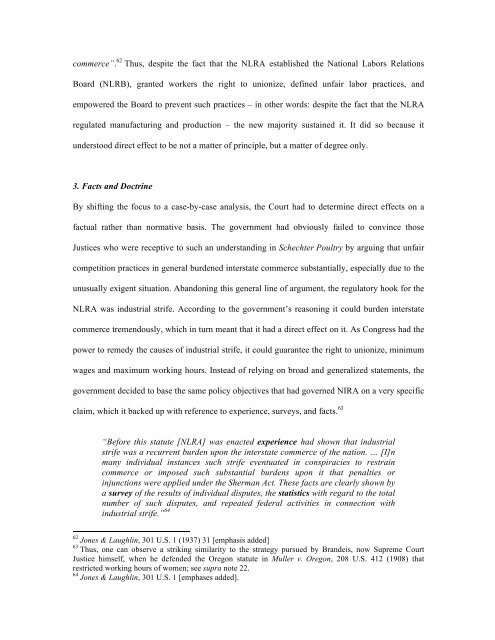Jasper Finke, Crisis and Law - New York University School of Law
Jasper Finke, Crisis and Law - New York University School of Law
Jasper Finke, Crisis and Law - New York University School of Law
Create successful ePaper yourself
Turn your PDF publications into a flip-book with our unique Google optimized e-Paper software.
commerce”. 62 Thus, despite the fact that the NLRA established the National Labors Relations<br />
Board (NLRB), granted workers the right to unionize, defined unfair labor practices, <strong>and</strong><br />
empowered the Board to prevent such practices – in other words: despite the fact that the NLRA<br />
regulated manufacturing <strong>and</strong> production – the new majority sustained it. It did so because it<br />
understood direct effect to be not a matter <strong>of</strong> principle, but a matter <strong>of</strong> degree only.<br />
3. Facts <strong>and</strong> Doctrine<br />
By shifting the focus to a case-by-case analysis, the Court had to determine direct effects on a<br />
factual rather than normative basis. The government had obviously failed to convince those<br />
Justices who were receptive to such an underst<strong>and</strong>ing in Schechter Poultry by arguing that unfair<br />
competition practices in general burdened interstate commerce substantially, especially due to the<br />
unusually exigent situation. Ab<strong>and</strong>oning this general line <strong>of</strong> argument, the regulatory hook for the<br />
NLRA was industrial strife. According to the government’s reasoning it could burden interstate<br />
commerce tremendously, which in turn meant that it had a direct effect on it. As Congress had the<br />
power to remedy the causes <strong>of</strong> industrial strife, it could guarantee the right to unionize, minimum<br />
wages <strong>and</strong> maximum working hours. Instead <strong>of</strong> relying on broad <strong>and</strong> generalized statements, the<br />
government decided to base the same policy objectives that had governed NIRA on a very specific<br />
claim, which it backed up with reference to experience, surveys, <strong>and</strong> facts. 63<br />
“Before this statute [NLRA] was enacted experience had shown that industrial<br />
strife was a recurrent burden upon the interstate commerce <strong>of</strong> the nation. … [I]n<br />
many individual instances such strife eventuated in conspiracies to restrain<br />
commerce or imposed such substantial burdens upon it that penalties or<br />
injunctions were applied under the Sherman Act. These facts are clearly shown by<br />
a survey <strong>of</strong> the results <strong>of</strong> individual disputes, the statistics with regard to the total<br />
number <strong>of</strong> such disputes, <strong>and</strong> repeated federal activities in connection with<br />
industrial strife.” 64<br />
62 Jones & Laughlin, 301 U.S. 1 (1937) 31 [emphasis added]<br />
63 Thus, one can observe a striking similarity to the strategy pursued by Br<strong>and</strong>eis, now Supreme Court<br />
Justice himself, when he defended the Oregon statute in Muller v. Oregon, 208 U.S. 412 (1908) that<br />
restricted working hours <strong>of</strong> women; see supra note 22.<br />
64 Jones & Laughlin, 301 U.S. 1 [emphases added].
















